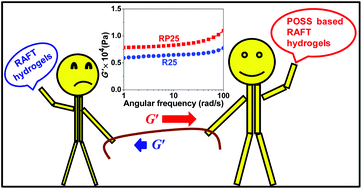POSS-induced enhancement of mechanical strength in RAFT-made thermoresponsive hydrogels†
Abstract
To understand the effect of polyhedral oligomeric silsesquioxane (POSS) moieties on the rheological properties of thermoresponsive hydrogels, poly(ethylene glycol) methyl ether methacrylate (PEGMA) based gels have been synthesized via conventional free radical polymerization (FRP) and reversible addition-fragmentation chain transfer (RAFT) polymerization techniques. Two different chain transfer agents (CTAs), namely 4-cyano-4-(dodecylsulfanylthiocarbonyl) sulfanylpentanoic acid (CDP) and a POSS chain-ended CTA (POSS-CDP) have been employed for the RAFT polymerization of PEGMA in the presence of a di-functional cross-linker, di(ethylene glycol) dimethacrylate (DEGDMA). Swelling, deswelling and reswelling behaviors due to the introduction of the POSS moiety have been systematically examined and compared with the CDP based hydrogels at similar compositions. The surface topology and structural porosity of the hydrogel matrix are examined by field emission-scanning electron microscopy (FE-SEM). The mechanical behavior of the swollen hydrogels has been investigated through rheological measurements. Interestingly, we find that the mechanical stability of the hydrogels improved by increasing both the cross-linking density and total net fraction of the POSS moieties.


 Please wait while we load your content...
Please wait while we load your content...